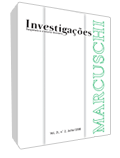Intertextualidade em textos universitários
Abstract
A análise da intertextualidade nos gêneros textuais escritos por alunos degraduação visa mostrar tanto a gradual aquisição de conhecimentos específicos a diferentes áreas disciplinares quanto a aquisição dos padrões ou cânones de expressão desse conhecimento. Tomando a intertextualidade como as relações explícitas e implícitas que um texto estabelece com outros textos, ela é vista não somente como uma questão dos outros textos a que um escritor se refere, mas também como esse escritor usa esses textos, para quê os usa e como se posiciona diante deles para elaborar seus próprios argumentos.References
ALLEN, Graham. 2000. Intertextuality. London: Routledge.
BAUMAN, Richard. 2004. A World of Others’ Words: cross-cultural
perspectives on intertextuality. Oxford: Blackwell.
BAZERMAN, Charles. 2007. Intertextualidades: Volosinov, Bakhtin,
Teoria Literária e Estudos de Letramento. In —: Escrita, gênero e interação social. São Paulo: Cortez, p. 92-109.
______. 2006. Intertextualidade: como os textos se apóiam em ouros
textos. In —: Gênero, Agência e Escrita. São Paulo: Cortez, p. 87-103.
______. 1988. Shaping Written Knowledge. The genre and activity of the
experimental article in science. Madison: University of Wisconsin Press.
BERKENKOTTER, C. T.; HUCKIN, T. 1995. Genre knowledge in
disciplinary communication. Hillsdale, NJ: Lawrence Erlbaum.
______.; ______.; ACKERMAN, J. 1991. Social context and socially
constructed texts: the initiation of a graduate student into a writing
research community. In: BAZERMAN, C.; PARDIS, J. (eds). Textual
dynamics of the professions. Madison: University of Wisconsin Press, p.
-215.
FAIRCLOUGH, Norman. 2005. Media Discourse. London: Arnold
______. 2003. Analysing Discourse. Textual analysis for social research.
London: Routledge.
HYLAND, Ken. 2000. Disciplinary Discourses. Social interactions in
academic writing. London: Longman.
KRISTEVA, Julia. 1974. Introdução à semanálise. São Paulo: Perspectiva.
MAINGUENEAU, Dominique. 2005. Gênese dos discursos. Curitiba: Criar Edições.
______. 1991. L’Analyse du discours. Paris: Hachette.
— MARCUSCHI, Luiz Antonio; DIONISIO, Angela Paiva. 2005.
Princípios gerais para o tratamento das relações entre a fala e a escrita. In:Fala e escrita. Belo Horizonte: Autêntica, p.13-30.
MEINHOF, Ulrike H.; SMITH, Jonathan, eds. 2000. Intertextuality and the Media: from genre to everyday life. Manchester: Manchester University Press.
Downloads
Published
How to Cite
Issue
Section
License
Copyright (c) 2008 Judith C. Hoffnagell

This work is licensed under a Creative Commons Attribution 4.0 International License.
Authors who publish with Revista Investigações agree to the following terms:
Authors retain copyright and grant the journal right of first publication with the work simultaneously licensed under the Creative Commons Attribution 4.0 International (CC BY 4.0) license that allows others to share the work with an acknowledgement of the work's authorship and initial publication in this journal.
Authors are able to enter into separate, additional contractual arrangements for the non-exclusive distribution of the journal's published version of the work (e.g., post it to an institutional repository or publish it in a book), with an acknowledgement of its initial publication in this journal.
You are free to:
Share — copy and redistribute the material in any medium or format for any purpose, even commercially.
Adapt — remix, transform, and build upon the material for any purpose, even commercially.
The licensor cannot revoke these freedoms as long as you follow the license terms.
Under the following terms:
Attribution — You must give appropriate credit , provide a link to the license, and indicate if changes were made . You may do so in any reasonable manner, but not in any way that suggests the licensor endorses you or your use.
No additional restrictions — You may not apply legal terms or technological measures that legally restrict others from doing anything the license permits.

